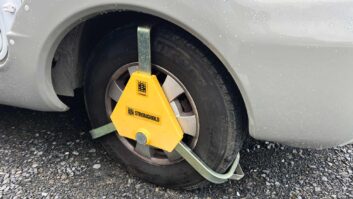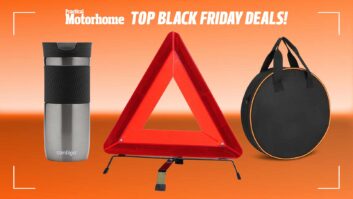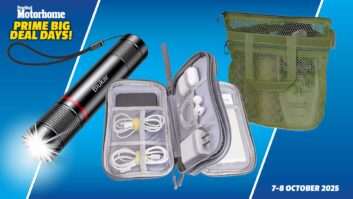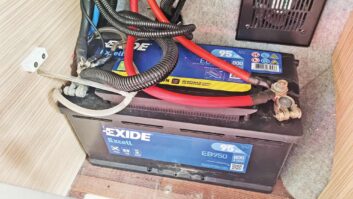Motorhomes and campervans are incredibly popular at the moment and if you were one of the many thousands who visited the February NEC Show, you’ll have been pretty amazed at the footfall.
Due to Brexit, Covid, war, silicon chip shortages and the energy crisis, there is a distinct scarcity of vehicles and parts. Coupled with the continuing high demand, this has created a perfect opportunity for criminals.
The price that they can get for selling on stolen vehicles and parts has never been higher. So there’s currently a far greater incentive for them to target motorhomes.
As well as stealing entire vehicles, though, thieves can also purloin items from your ’van. Our ‘vans make an appealing target because they often carry more in the way of high-value equipment than cars, such as motorhome TVs or campervan projectors and once inside – with the blinds down – the thieves can rifle through it at their leisure.
In many ways, the theft of items from inside your vehicle is a more insidious crime than the whole vehicle disappearing – it’s as if somebody has violated your home space. This can be a deeply disturbing experience.
Who is stealing vehicles?
It’s difficult to describe the typical leisure vehicle thief – they can range from the solo opportunist to large gangs of professionals – but specialist law enforcement teams dealing with stolen vehicle recovery often have to focus on those gangs of professional thieves, who will usually steal vehicles in Europe to sell in the UK, or vice versa. They are highly specialised and have connections to organised crime across Europe.
The gangs are technically capable, too, having access to key-making machines and alarm decoders.
To be frank, there’s not a great deal you can do to prevent professional thieves from taking your motorhome. They will operate very rapidly and very effectively – apparently, they often aim to have the stolen vehicle shipped out of the UK within the hour.
What are the police doing?
One of the key problems with vehicle theft is how easily vehicles can be cloned. Simply find a similar model online, copy the numberplates and sell it on to an unsuspecting customer (ideally one who doesn’t know where the chassis VIN plate or engine number are located), explaining that you’ve ‘lost’ the V5C logbook.
Rather frustratingly, the DVLA’s registration system doesn’t yet link to the CCTV network around the UK. This means that you can have multiple vehicles cruising around the motorway system at the same time, all with the same numberplates showing.
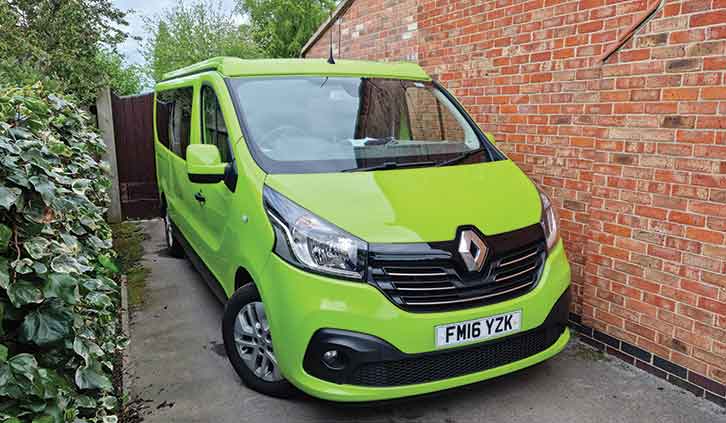
What’s more, an HPI check will not flag up any problems, either. This is why it’s so important to always check the VIN plates against the V5C logbook (no logbook is a red flag – walk away) and ask the seller to show you photos of their vehicle on their phone.
This latter (clever) tip comes from the police: a genuine seller will always have taken shots of their pride and joy.
To get to grips with the cloning issue, the police are developing a computer system that will monitor the whole CCTV network and check for signs of any duplicate numberplates.
If they deem a journey is physically impossible – for example, a vehicle has been seen in London at 1pm and then in Edinburgh at 1.30pm – the system will raise an automatic alert.
Free things you can do
In these cash-strapped times, we’re all looking for ways to motorhome on a budget and are keen to save a bit of money where we can, so what can you do to help prevent motorhome theft?
One of the easiest things is to always make sure you park up with the wheels angled to one side – preferably into a nearby obstacle, such as a wall, tree or fence. This makes it far more difficult to winch or lift away the vehicle.
Theft of items from vehicles is often committed by opportunists, who tend to be serial offenders undeterred by the prospect of community service or a bit of prison time. To discourage them, don’t leave anything on show and don’t advertise the contents of your vehicle by having stickers on the outside. Displaying a ‘Harley Davidson’ sticker on your box trailer is just asking for somebody to break in!
Physical security devices
The main drawback with all physical security devices is that they’re only ever as strong as the item to which they are bolted. Thieves have no qualms about breaking extra locks, cutting your door handles to remove chains or chopping out a section of steering wheel to deal with a lock.
Your motorhome is also surrounded on all sides by plastic windows, often with plastic catches, which means gaining access isn’t that tricky.
What all of these security devices do is to deter thieves and slow them down. They won’t make much odds to a professional – it’s their full-time job and they deal with this kit every day.

Bar-style steering wheel locks are, in my opinion, perhaps the least effective – they’re only as strong as your steering wheel rim, and can sometimes be used by thieves to gain extra leverage when breaking the steering wheel lock. They could potentially wrench the thing off or cut the steering wheel rim.
Steering wheel locks that cover the entire wheel are far more effective, but can be bulky and heavy to store in your ’van when you tour. Cheap, untested ones may be prone to drill attack, too.

Pedal-locking devices are an excellent idea, but can be inconvenient to fit and are not suitable for all motorhomes. They are also not as much of a visual deterrent as other mechanical items.
With all mechanical security gear, you should be sure to pick a unit that is convenient to use. If your vehicle is kept locked up like Fort Knox, it might spoil your use of it and might put you off touring regularly. As with most things, this is a balancing act. The best motorhome wheel clamp can be an important security accessory but for those who regularly use their ‘van, can be a pain to keep taking off and reattaching.
The best source of advice is from the independent leisure vehicle press (which you’re reading), or from groups such as Thatcham and Sold Secure, who independently test mechanical security products – see their websites for their ratings.
Vehicle key theft
The most common method for stealing motorhomes is simply to use the keys. Modern immobilisers are integrated into the ECU and can’t be hot-wired, so having the original key is the easiest way to steal it.
If you leave your keys within sight of a window or hung up near the front door, they’re vulnerable to being fished out of your letterbox with a stick or a telescopic pole.
Keep them out of sight of windows and doors, or better still, store them in a locked key box or safe.
Relay box theft
This method of theft only affects those vehicles that unlock the doors when you have the keyfob in your pocket and walk near the ’van. If you have to press a button on the fob to unlock the vehicle, it’s not keyless entry and is therefore not prone to this form of attack.
Some keyfobs broadcast a constant low-range radio signal – these are particularly vulnerable to thieves.
Relay boxes can be cheaply bought on the internet and consist of two elements – a relay-boosting box that is placed as close as possible to the original key (for example, if it’s hung up in your hall, they’ll put the relay box near the front door) and then boosts the signal to a duplicate key or box near the vehicle.
The vehicle is fooled into thinking that the key is nearby and obligingly unlocks the door for the thief. With a press of the starter button, they’re away and can disable the alarm at their leisure in a discreet lock-up.
We found several such boxes freely available online (for a few thousand dollars), with the websites even listing which vehicles they opened! If you think it was all older models, guess again – some the vehicles detailed were from as late as 2020.
Modern vehicles no longer broadcast a constant signal, so are less vulnerable, but keyless entry has been a complete disaster for vehicle theft figures. You can help prevent it by keeping keys well away from doors and windows, and placing them in a Faraday box or pouch, which stops signals escaping.
Immobilisers and alarms
Most modern vehicles will have an immobiliser built into the ECU, and the idea that they can be hot-wired Hollywood-style simply by touching two wires together under the dash is nonsense.
However, if you are the proud owner of a classic campervan or motorhome, these are rather easier to steal, because they don’t have extra security systems fitted as standard.

Although many classic vehicles are not actually that valuable, some of them are – just look at the prices of classic Volkswagens – so it’s well worth adding extra security.
Some alarms – such as the Van Bitz Growler – emit such an ear-piercing siren, it is impossible to be inside the vehicle for any length of time without ear protection. Clearly, this will make things difficult for the thief (and you, should you inadvertently set it off!).
You might also want to think about fitting an extra alarm or immobiliser, and there are many brands available on the market. You can select one that’s approved by Thatcham by visiting its website.
Tracking units
We’re big fans of trackers, because they are an excellent, non-invasive way of keeping tabs on your vehicle when you’re not nearby.
As well as being able to monitor if the vehicle moves, trackers usually have alerts to warn of towing, vibration and whether the vehicle has been jolted. So they will also alert you if somebody bumps into your ’van in a car park.
By setting a geofence around your vehicle, you will receive an immediate alert if it moves outside this preset area. This allows you (or a monitoring service) to take rapid action if your vehicle is stolen.
Trackers also allow you to remotely monitor your battery voltage, so you know if your vehicle battery needs charging, or if somebody has switched on the ignition system. This is really helpful if you’re storing a motorhome remotely – you can see if the battery requires topping up simply by tapping through the app on your phone.

Some insurers insist on motorhome owners having an insurance-approved tracker fitted, and these tend to be quite a bit more pricey than DIY-fit ones, with higher annual subscriptions.
The DIY trackers work well and have cheaper subscription costs – for example, the Rewire Security DB2 costs around £35 (on Amazon), plus £60 annual subscription.
They do offer Thatcham-approved trackers, with their S7 model costing £150 plus £150 a year subscription fees. The ‘full monty’ S5 Plus is £350 plus £200 a year subscription. The prices for their Thatcham-approved systems include free UK mainland installation.

Not all trackers are accurate enough for the police to locate your vehicle (and not all forces have the capacity to investigate vehicle theft), so bear this in mind with potential purchases. If it is safe to do so, you might have to recover the motorhome yourself.
But a tracker can alert you rapidly of theft, and it’s this speed of response that is critical to recovery.
Factory-fitted trackers
One issue with factory-fitted tracking units can be that motorhome manufacturers are working to mass production deadlines, and some might fit all their tracking devices in the same place in the vehicle.
Thieves become accustomed to this and will actively target vehicles from that manufacturer. They then rapidly remove the tracking device and have even been known to goad the police by leaving the unit on a fencepost, or at the side of the road. The battery back-up of these devices means they can continue operating for days.
So even if you have a factory-fitted tracker, it’s still worth installing some additional protection, or even adding a second tracking device.
The Vin Chip
One of the problems faced by the police is identifying stolen vehicles when they have been recovered from a theft. Changed numberplates and altered VIN numbers make trying to get vehicles recovered to their rightful owners (or the insurance company) a challenge.
A police security initiative is the VIN Chip, an identification product that sees various RFID (radio-frequency identification) chips dotted around a leisure vehicle. These passive chips are not battery powered and never go flat, so they can be detected by police equipment and they hold the unique VIN Chip for your vehicle, which is linked to a database.
They’re also tiny, so can be hidden in all sorts of crevices on a motorhome. As well as the RFID chips, the kit also includes tamperproof security stickers for the vehicle windows, and microdots, minute tags carrying the unique code for your vehicle’s kit.
This product was initially launched for the caravan market, but they are now focusing on motorhomes, offering various kits with prices starting from £47.99 for a two-chip set and rising to £84.99 for a five-chip kit with lots of labels and microdots. This is a one-off cost, with no subscription, and can undoubtedly help identify your vehicle if it is recovered. Those warning labels will certainly help to deter thieves, too.
Insurance
It almost goes without saying that of all the excellent security devices featured here, the best form of defence is in fact your insurance policy.
For any motorhome, it’s important to have an appropriate level of cover from a specialist provider, one that really understands the specific needs of leisure vehicle owners.
It makes sense to use a company that has good reviews, or is recommended by friends and family. Buying on price alone is not the best approach when it comes to insuring a high-value item such as a motorhome.
A specialist insurance provider will make sure that a high level of contents cover is included in your policy, and that other expensive items – such as ebikes or awnings – are also covered.
These items can sometimes be overlooked in van- or car-style policies, but are of importance to motorhomers who carry everything – including the kitchen sink!
Before you sign on the dotted line, make sure to read the small print and check that every high-value item is listed on the policy schedule.
Verdict
Being aware that leisure vehicles are a target and being prepared is half the battle – you shouldn’t feel as though you have a target on your back.
So long as you take a few practical precautions and have good insurance, you should be fine. We’d also highly recommend adding a VIN Chip to your leisure vehicle – it is a police-approved product backed by the leisure industry.
Future Publishing Limited, the publisher of Practical Motorhome, provides the information in this article in good faith and makes no representation as to its completeness or accuracy. Individuals carrying out the instructions do so at their own risk and must exercise their independent judgement in determining the appropriateness of the advice to their circumstances and skill level. References to specific products are for illustration only and not intended as recommendation. To the fullest extent permitted by law, neither Future nor its employees or agents shall have any liability in connection with the use of this information. Double check any warranty is not affected before proceeding.
If you’ve enjoyed reading this article, why not get the latest news, reviews and features delivered direct to your door or inbox every month. Take advantage of our brilliant Practical Motorhome magazine SUBSCRIBERS’ OFFER and SIGN UP TO OUR NEWSLETTER for regular weekly updates on all things motorhome related.




